Loading the blog

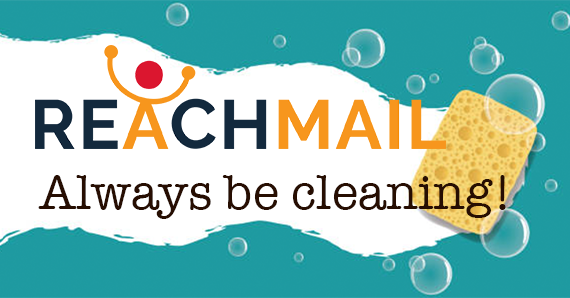
ReachMail has some great tools to help you always be cleaning. But what is the difference between List Cleaning and List Sweeping? Isn’t sweeping part of cleaning? Do they do the same thing? Is only sweeping or cleaning enough? Do I need both of them? A study conducted by ITProPortal suggests that the pandemic has accelerated the rate of data decay by an average of 0.5 percent per month, resulting in annualized rate of 37.5 percent. How can you keep this from affecting your deliverability? Just keep cleaning, just keep cleaning, just keep cleaning… We have introduced a new tool titled List Maintenance to help you always be cleaning.
List Maintenance was designed to make managing your list a lot easier. Our list maintenance performs bulk actions that you can select to remove emails from your list. This tool removes your lists' hard bounces, soft bounces, opt-outs, and now disengaged contacts. You can perform list maintenance after every send. It is up to your marketing team how often you wish to remove those contacts from your mailing list, but our recommendation is as often as possible. Now you can rid your list of those who are either not getting or not engaging with your message. Always be cleaning.
List Cleaning should be an infrequent occurrence per list. ReachMail list cleanings perform both hygiene and verification checks on your list data. Hygiene checks identify spam traps, zombies, complainers, bots, seeded trackers, moles, etc. These traps, zombies, and bots are valid email addresses. Your email will get delivered. BUT they will harm your deliverability. Verification checks determine if the address is valid. Over time traps could even lead to black-listings. An excellent general rule is to clean your data at least once a year. People change jobs and stop using personal email accounts regularly (the new standard in some cases is email addresses change every six months). Use your industry-specific knowledge to your advantage too. If your industry has a high turnover rate for employment, consider that you may need to run a list cleaning more frequently. Think of this as your spring and/or fall cleaning and definitely upon initial upload.
Contact support@reachmail.com with all your cleaning needs, and we will be happy to provide insight on how to help you always be cleaning.
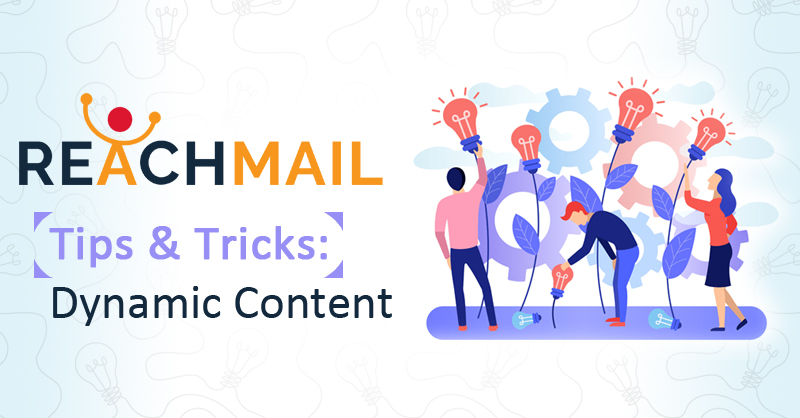
Dynamic content in email is any personalization that changes the content sent to a recipient based on a user's behavior or data you have collected. You're probably already using dynamic content in your messages without realizing it. Dynamic content in its simplest form is Personalization. Dynamic content-based emails stand out in the inbox as tailor-made for the recipient and increase engagement.
In this post, we hope to provide you with the tips you need to take your email marketing to the next level. Afterward, you'll be able to leverage the power of ReachMail's Dynamic Content tools to keep your brand top of mind and foster a positive relationship with your audience. Personalizing your message gives your recipients a sense of importance, which is why dynamic emails are becoming increasingly popular.
The most common example of dynamic content is Personalization, similar to Mail Merge in legacy office applications. Personalization allows you to use any field in your contact database to populate the content sent to a given recipient. It could be as simple as the recipient's name or more complex like customer id, unique coupon codes, sales representative names, and so on.
Dynamic sections are another way to create a unique experience for your recipients. ReachMail's Dynamic Content tools offer utilities that allow you to create custom sections of content (text and/or images) that we will only show to recipients who match specified criteria. You can use any field in your customer data as the criteria, creating unlimited possibilities.
With great possibility comes great power, which is why we outlined a detailed example below.
The concept for this example is that you run a clothing store. You have many customers in the midwest and customers on the southeastern coast. Running a clothing store across the entire country requires knowledge of whether you should be promoting winter or summer clothing options.
For this example, we want to target customers in the midwest with content that matches the type of weather they are experiencing. We can change images and text in the mailing using dynamic sections depending on if recipients live in the midwest or not.
For the midwest, we will target the states 'IL,' 'IN,' 'MI,' and 'WI.'
The first thing to check is that your list has the necessary criteria. In this case, we want to make sure we have "state" included as a field in our list data.

Once you have checked your list, you will want to create your content. In this case, we have a standard template, where the main picture of the content will be dynamic based on what "state" field our recipients have.

To begin creating the dynamic section for this content, you'll want to use the "Dynamic Content" drop-down option in the Advanced Editor.

After clicking on Dynamic Content, a new window will appear titled the Dynamic Content Builder. To get started, select a List Element. The element chosen here is the comparison base for the dynamic content condition. The data represented in this column will determine the mailing content for each recipient.
After choosing a list element, you'll want to choose between an IF, ELSE IF, or ELSE condition. In this example, we will be adding an IF statement for the states in the midwest. Then an ELSE statement for all other states. If you select an IF or ELSE IF statement, you must pick an operator. Operators are used to compare the list element to a conditional value. Below is a list of operators available.
For this example, we will be selecting an IN operator with the value IL, IN, MI, WI. Doing this lets us declare that if the State is In Illinois, Indiana, Michigan, or Wisconsin, it will display the winter image. Clicking on the Save button will add this condition.

Next, we will add an Else condition to handle all other circumstances. If the State field is anything other than IL, IN, MI, WI, or even if it's blank, it will show the summer image. Click the Save button to add this condition.

Once you've saved all your conditions, you'll receive a summary showing each condition type, statement, and content.

Once you've accounted for all your conditions, you'll want to click the Save button to insert your dynamic content code. The source of our code will be a complete statement with all the content we detailed above.
{{% IF state IN [IL, IN, MI, WI]}}<img class="adapt-img" style="display: block; border: 0; outline: none; text-decoration: none; -ms-interpolation-mode: bicubic;" src="https://qqwqq.stripocdn.email/content/guids/CABINET_ad46fda24f01523c001e0fdfdecc5bfc/images/winter.png" alt="" width="350" />{{% ELSE}}<img class="adapt-img" style="display: block; border: 0; outline: none; text-decoration: none; -ms-interpolation-mode: bicubic;" src="https://qqwqq.stripocdn.email/content/guids/CABINET_48fae94f15fabdeea80672c2b16045bb/images/summer.png" alt="" width="350" height="525" />{{% END IF}}
ReachMail will render this code in the advanced editor. Please note that our editor doesn't consider the dynamic conditions, so what the editor generates will not be what your recipients receive.

Combining all we learned above, the merged process should look like the displayed example.
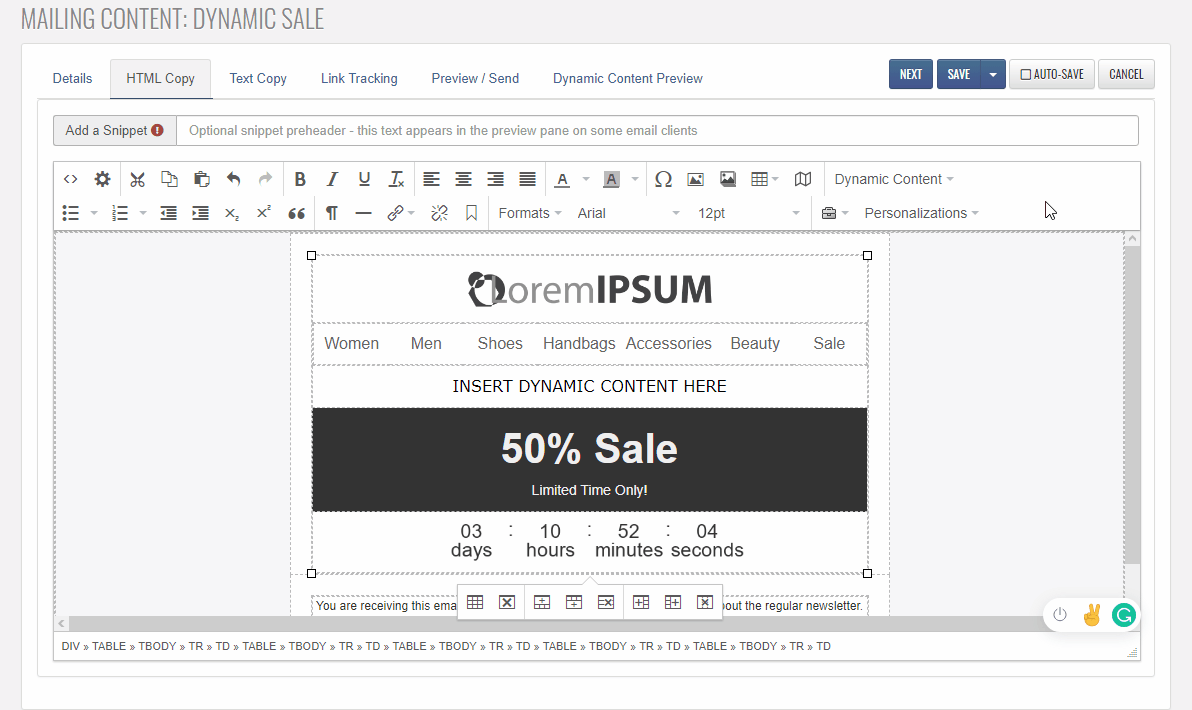
The last step in the process will be to preview your dynamic content. Using the dynamic preview is the best way to understand what your end recipient will see. To preview your dynamic range, select the Dynamic Content Preview tab. Once clicked, you'll be able to view the following.
We recommend using this tab to test different dynamic criteria that can change the mailing for your end recipients. In this example, we will be entering a value that matches our IF statement. Afterward, we will be joining a value that will encompass our ELSE condition.

You can check out our reference guide for complete documentation on creating dynamic statements or contact us with any questions.
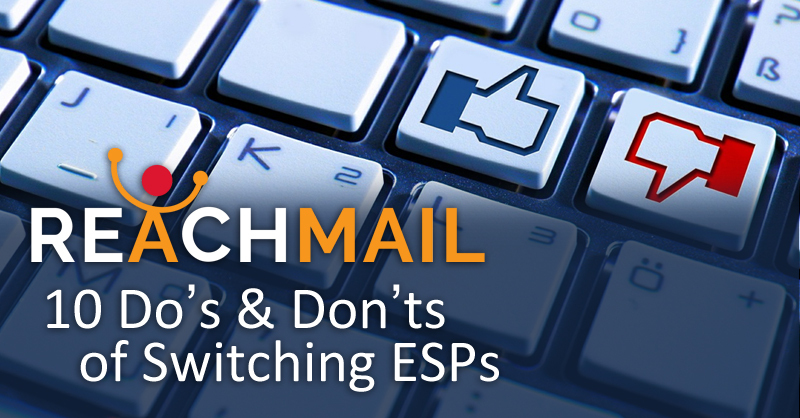
Anyone who sends promotional or transactional emails professionally can attest to the often complex nature of a brand’s email messaging campaigns. Switching to a new Email Service Provider (ESP) can sometimes be a chore, but it doesn’t have to be. A few quick steps and you’re on your way to reaching your customers. ReachMail put together this Dos and Don’t of Migrating ESPs blog to help. For a more detailed look, be sure to check out the Migration Guide & Checklist White Paper.
Migrating ESPs can be quick and painless when done correctly. However, rushing through a switch in ESPs can lead to problems that slow down progress or even bring things to a halt. With the following do’s and don’ts, you can switch to a new ESP safely and quickly.
1. Ensure you send to an audience who consented to receive your messages and still wants to receive your offers.
Opt-in consent from your audience ensures you have permission from each recipient to email them. Beyond the initial opt-in, it is crucial to understand that consent is not a permanent pass to email recipients. A recipient may revoke consent at any time.
Consent, with regards to email marketing, carries with it additional factors. For example, the wrong offer or a poorly timed message can cause audience members to revoke consent.
2. Keep track of who has unsubscribed from previous emails and ensure they are opted out in the new ESP before sending.
In practical terms, pay close attention to what is exported from the old ESP. If you are not careful, it is possible to accidentally download all recipients, including addresses that are no longer valid or have previously unsubscribed. Only export/download Active recipients from the old ESP.
ReachMail provides a Global Opt-Out List for your account, allowing you to automatically suppress previously unsubscribed recipients from all List imports and Campaigns.
3. Ensure that your DNS records are in order and that your email is authenticated correctly before sending with the new ESP.
Authenticating your emails ensures that mailbox providers can trust your messages. If you are DKIM signing emails with the old ESP but fail to do so with the new ESP, your new emails may appear suspect to ISPs and spam filters. Make sure you set up DKIM and SPF records and DMARC/BIMI if applicable.
4. Maintain the continuity of your messages.
Continuity of your branding will help ensure recipients continue to receive your emails in their inboxes. While a switch to a new ESP is often a good time to experiment with new segmentation methods (don’t be afraid to shake things up a bit trying to improve results), you must maintain the consistent branding of your messages.
5. Prioritize delivery to the most engaged recipients.
As you begin sending with the new ESP, you will be establishing a new Sender Reputation. This period will vary depending on your prior Sender Reputation at other ESPs, but it is essential to start with the most active part of your audience first. Establishing a good Sender Reputation can only happen when recipients react positively to your emails.
1. Don’t wait until the last minute to start migrating to the new ESP.
Switching to a new ESP can take some time. But, as you can find in the Migration Guide & Checklist, a well-laid-out plan of action can help avoid a lot of costly mistakes that slow you down.
Support and Deliverability staff at ReachMail can see you through your specific situation.
2. Don’t rush the migration.
Migrations can be quick when done correctly. However, early mistakes will slow down the migration process and can even bring things to a halt. It is better to go slow at the onset to gauge response rates at the new ESP than to rush to send. Warm email traffic for the best deliverability. ReachMail’s List Warming tool can set up a volume ramp-up cadence in just a few clicks.
3. Don’t prioritize a deadline over attaining desired delivery results.
While an upcoming deadline for an event can seem like the top priority, there are often creative ways to handle such situations. For example, marketers may opt to use the old ESP to send out a few final Campaigns while continuing to follow best practices at the new ESP by warming email traffic.
If you prioritize the deadline over achieving the delivery results you want at the new ESPs, it can appear like an abuse of the trust your brand has established with ISPs (Sender Score). ISPs use reputation-based spam filters. Failing to respect those filters is a quick path to the spam folder, which can set your ESP migration back weeks.
4. Don’t forget to thoroughly vet data with List Cleanings (data hygiene) before sending.
Email Data Hygiene has been a growing concern for email marketers for many years, and the importance of thoroughly vetting email lists has never been more critical. Spam fighting networks use newer and more sophisticated methods of detecting problematic senders, and List Cleanings help remediate those problems before they affect your deliverability.
Sending to invalid email addresses and opt-outs constitute only a small portion of possible threats to successful delivery to the inbox. Spam Traps of all varieties do not bounce, and some will open and click on emails occasionally to remain undetected in your lists. Therefore, simply the act of sending to a spam trap is considered abuse, even when no complaints are reported.
5. Don’t hesitate to reach out for help or advice.
When in doubt, ask for help! ReachMail’s support and deliverability staff are on hand to help guide you through a successful switch. We know that an ESP migration can sometimes be tricky. Flexible pricing plans let you self-manage your needs as you go, and our team of experts is here to help.
When challenges arise, don’t hesitate to reach out for help. Our mission is to give you honest and actionable advice.
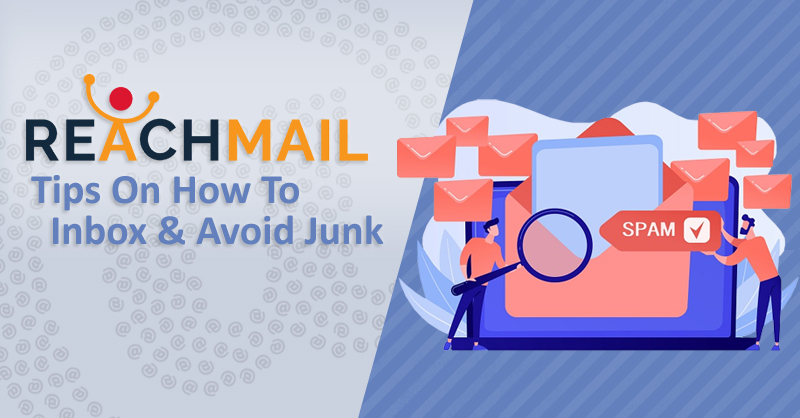
If you are engaged in any kind of personal or business activity that involves bulk email delivery, you need to know how to get the most out of your emails to maximize results. That means keeping your emails out of the junk folder and in the inbox. We'll look at reasons why emails go to spam, how you can spot changes and be proactive, what you can do to prevent or recover from problems, and the ways ReachMail helps its senders keep their emails in the inbox. First, though, let define spam clearly.
A quick side notes: this post revisits a popular topic that we've covered in a previous post.
Spam is not a content issue, but instead a matter of consent. Spamhaus provides a detailed explanation of this definition which can be summarized as "A message is Spam only if it is both Unsolicited and Bulk."
It is important to start with a clear understanding of how the receiving end thinks about spam emails. Ultimately the decision to accept (deliver) or deny (bounce) an email and whether that email is put in the spam folder or the inbox is entirely up to the network receiving the emails. Laws that govern email like CAN-SPAM, CASL, or even GDPR are largely irrelevant to the question of spam folder delivery. Networks filter emails to best serve and protect their customers from fraud and abuse. In so doing, mailbox providers implement far more stringent policies than anything written into law.
Taken from Spamhaus:
An electronic message is "spam" if (A) the recipient's personal identity and context are irrelevant because the message is equally applicable to many other potential recipients; AND (B) the recipient has not verifiably granted deliberate, explicit, and still-revocable permission for it to be sent.
(A) defines Bulk email delivery.
(B) defines the type of consent that is required by which a spam evaluation is made.
This requirement of Explicit Consent explains why third-party email lists, whether purchased, leased, or obtained through any form or indirect consent, will often run afoul of spam folder delivery. Explicit Consent is only obtained when recipients opt-in to receive an email directly from you.
Many factors are involved in any network's decision to filter email into your recipient's inbox or spam folder. Each network is slightly different from the other, but the general theme is that positive recipient engagement is central to the entire process.
Email delivery results will vary somewhat from industry to industry, but the following average delivery rates can be good indicators for measuring success.
open rate - the measure of how many recipients opened. (Opened / Sent)
click-through-rate - the measure of how many recipients clicks. (Clicked / Sent)
click-to-open-rate - the measure of how many openers also clicked. (Clicked / Opened)
unsubscribe rate - the measure of how many recipients unsubscribed from this email. (Unsubscribed / Sent)
Note these tend to fall under the long-held general guidelines that have remained consistent for many years: Open rates above 15% and Opt-Out/Spam rates below 0.1%.
Focusing on the open rate helps you match your email delivery to the best practices and guidelines listed at each network. Networks want you to send to recipients that are interested in the emails. They want their users to enjoy checking their email, not get annoyed digging through the spam. Users that get too much spam tend to abandon their email accounts too. Be careful where you source your email lists and how long you keep recipients around that never open. If you keep addresses around forever, you might be at risk for recycled spam traps and other list fatigue problems.
The more email you send to disinterested recipients, the more likely it is that they'll interact in negative ways, like reporting your messages as spam, deleting them, or even reporting them as abuse listing providers. Check out Google's guidelines for sending to gmail.com.
Networks like Google will penalize senders for continuing to send straight to the spam folder as well. The lower your open rates, the worse things can get if you don't take action quickly. List Cleanings and regular use of the Engagement Scanner tool we offer and quickly work on these problems.
You can also use bounce rates to understand better why email is being sent to spam. Hard Bounces are invalid emails, but Soft Bounces can vary widely in reason. As is the case with filtering email into the spam folder, each network will issue soft bounces somewhat differently. Still, generally speaking, the following guideline can offer useful benchmarks across all traffic.
Hard Bounce Threshold
Soft Bounce Thresholds
Soft Bounce thresholds can be used as a call to action when viewed in the right context. Open rates are important but they do not paint a complete picture by themselves. Delivery blocks are generally levied by a network in response to abusive/unwanted email. Networks often throttle inbound emails, delivering some to recipients to gauge response rates and interest. If enough of these recipients respond by clicking the spam button or interact in other negative ways, the messages may be placed in the spam folder or rejected (Soft Bounced) in order to protect their users from spam. As such, removing soft bounces provides no remedy to the problem at hand, and often leads to the loss of valuable and potentially interested recipients in the process.
Using the Compare Campaigns Reports feature is a great way to see these open, click, bounce, and unsubscribe rates as they change over time too. Spotting an increase in soft bounces can be the first step towards knowing where and when to take action.
The following targets should be understood as industry averages and may differ slightly from sector to sector. Especially for open rates, senders are encouraged to aim for open rates above 25%-35% as often as possible. Senders regularly attain 50+% open rates on targeted offers. When meeting or exceeding these metrics below, it can generally be inferred that your messages are arriving in the inbox without issue.
Open Rate 15% - 20% or higher
Soft Bounce Rate below 5%
Hard Bounce Rate below 1%
Spam Complaint Rate below 0.1%
It can seem unpleasant to hear that parts of your audience are no longer interested but we like to think of it a bit differently: You're busting your butt to provide a great service! Some people clearly recognize that too! Those are the openers and clickers. Part of growing your audience is taking strides to retain the existing customers of all interest levels, but what's wrong with giving preference to those that are most interested? Don't be afraid to set aside customers that stop opening and clicking for a period before trying to re-engage them.
Recognizing that recipients are individuals with their own preferences and tastes that can change over time helps you interact with your audience on their terms. The goal of the re-engagement messages should be to drive an interaction like a reply, link click, etc. Sending to recent openers will improve inbox placement. Sending the non-revenue, engagement driving offer after a few weeks of improving inbox rates helps you re-engage more recipients.
At some point, after reasonable attempts have been made to re-engage a recipient it is imperative to remove old email data permanently from your email lists. Failure to remove old email data in a timely manner can result in the collection of recycled spam traps and other old data markers that networks use to identify and block spam. As a general rule, if an address has been inactive for more than a year, it may be a potential threat to delivery results and reaching the inbox.
The best delivery results are achieved by marketing to recipients on their own terms and minimizing the efforts wasted marketing to those that have already lost interest. Prioritizing offers to the most interested and removing the old addresses that never respond can be facilitated in many ways like Tags, Preference Centers, Auto Messages, and Automated Follow Up emails.
Networks use many tools and subversive tactics to identify, filter, and block spam email. One of the biggest risks of sending to third-party email lists is that some spam-fighting networks will seed their spam traps into lists that data brokers sell. Open sign-up forms are targeted by spambots to check for COI (confirmed opt-in) consent as well. Some spam traps are placed on websites but hidden so that people that scrape sites for addresses will collect them in their lists. These kinds of spam traps are referred to as Pristine Traps.
Networks recycle abandoned email accounts too. These are called Recycled Traps and can occur when senders fail to remove non-responders in a timely manner. Recipients that opted in a long time ago, but have since abandoned their email addresses may be recycled into spam traps and used to identify spam.
You can collect both even if you never buy an email list. Running a COI sign-up form, and using ReachMail's SignUp Shield services help protect you from traps before you send. Even if you don't use ReachMail's sending services or sign-up forms, you can still integrate our List Cleaning services via our Zapier integration.
Networks also use metrics like Hard Bounces above 1%, or Spam Complaints above 0.1% to place the email in the spam folder. Content evaluation still plays an important role for many networks, though these methods are informed by machine learning networks nowadays, and no longer bear much resemblance to the simpler spam filters of the past that focused on flagging specific keywords.
Keeping your emails in the inbox requires paying attention to campaign metrics. Compare your reports and keep track of any changes in the data. If soft or hard bounces are going up or open ratings are going down, take this as a sign to readjust. Remove those who are not opening or clicking and ensure that the offers you're sending are being received positively. If you're receiving spam reports on your campaigns or a high number of opt-outs, it may be a sign that the content or permission of your list data is the issue. Keep close attention to opens and clicks to track what interests your audience.
By 9:30am CST, 12-16-2020, after confirming Google had resolved the problem on their end, ReachMail reactivated any gmail.com hard bounce affected by the Google Service Outage in everyone's active sending Lists.
Campaigns scores are automatically calculated and hard bounces are heavily weighted in the score. ReachMail offers these scores as a quick way to review delivery metrics. Scores may look unexpectedly low, given the Google issue.
If you see a Lock icon next to your list, or an alert when you visit the Lists tab, a List has been locked for abuse. If you believe your list was locked as a result of Google's service outage, please let support@reachmail.com know and we'll investigate the issue and mitigate where applicable.
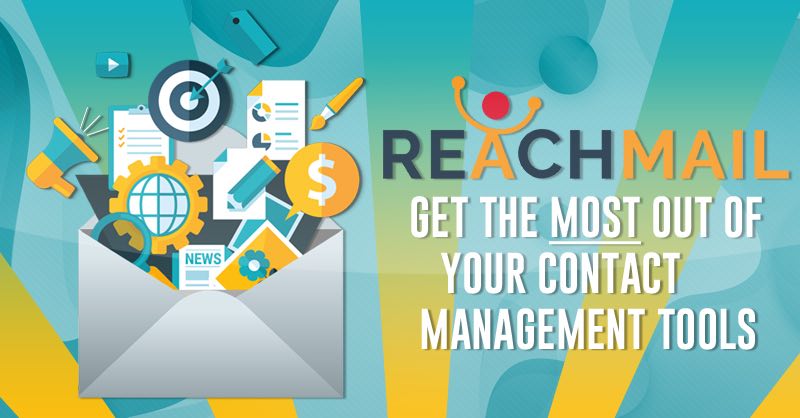
Avoiding list clutter may not sound like the sexiest of topics, but it’s nonetheless a critical part of every email marketer's routine tasks. Managing a segmented audience for targeted and personalized messaging can quickly become a burden if you’re not careful. A well honed data management strategy can go a long way towards improving engagement too.
But with a few simple tricks and automated actions, managing a diverse audience gets a lot more...well...manageable. Before we get started, let’s first look at why segmentation works.
Sender Reputation/Sender Score is really where Dynamic Segmentation comes in. Reputation systems (spam filters) place heavy emphasis on recent recipient interaction. It’s not enough to assume that all opt ins, or prospects from a past trade show want your next message.
Dynamic Segmentation implements a rolling filter for recently engaged recipients within your audience. Since mailbox providers are keeping track of how recipients interact with your offers when they decide whether to put your message in the inbox or not, Dynamic Segmentation makes sure you play by their rules, automatically.
Taking this idea a step further with Tags and Preference Centers, as you’ll see below, we find that treating an email list as individuals, each with their own tastes and preferences, enables personalized interactions with recipients, each at their own level.
At its simplest, inbox delivery is about sending relevant messages to people that want them today. If someone opted in a year ago but hasn’t opened any messages in the past 3 months, we can all agree that, in most cases, they are less likely to engage with today’s offer as the person who signed up a month ago and has opened the last 3 offers.
Dynamic Segmentation can handle the engagement filter while Tags and Preference Centers enhance segmentation in simple but meaningful ways that allow you to prioritize delivery efforts for recipients that are most interested. Not only that, but identifying people who are not as interested allows you to target them with special offers that help them re-engage.
Personalized delivery lets you target all your recipients in the most effective way possible and can increase delivery performance for all your segments.
Tags are a great way to manage different types of clients in the same list. Unlike List Segments, which rely on a field in the List, multiple Tags can be added to a single recipient record, allowing for greeting filtering later on.
Preference Centers enable senders to Tag, track and target recipients by their interests. We make the flexible so you can set up a Preference Center for :
|
|
You are in full control of your Preference Center settings so you can tailor the Tag based segmentation to any need.
Sometimes you just need to add Tags to a set of addresses that you’ve already imported. The Tag on Import process lets you do this easily. Import a list of addresses to a current List in ReachMail, and use the Tagging options to update the existing records.
This lets you pre-define which set of recipients need to be Tagged.
If you need to Tag every recipient in a List, there is an option for that on the Tags page as well.
Sometimes you just need to break up a List into smaller parts. Whether you want to stagger delivery over a longer time period or simply limit the number of responses you get from a special offer, the List Split Tool is a quick way to break a list into virtual chunks.
By using Tags, your List stays intact (keeping all the engagement history in one place). Scheduled Campaigns and Auto Messages can use these Tags to segment recipients.
For anyone that hasn’t used Tags before, this feature is a huge help. Managing dozens of individual Lists can get tedious fast. By merging many Lists into a single List using Tags, senders can quickly reorganize extensive List portfolios into more manageable amounts.
Take the case of a Customer A who attended a trade show last month and also signed up via website sign up form. Instead of keeping two Lists, one for the trade show and one for form opt-ins, the Merge and Tag feature enables you to keep the customer in a single List while maintaining the initial segmentation.
ReachMail lets you Tag recipients automatically based on events (actions) in your Campaigns. When someone opens a particular message, we’ll add the Tag of your choice to their record. You can even do it on specific link clicks too.
With event driven tagging, ReachMail enhances your targeting options in a simple but powerful way.
While not a segmentation feature, per se, Campaign Templates are handy for saving your presets if you want to quickly reuse them later.
High Volume Email marketing has made a comeback! Enhanced tooling and analytics make it easier than ever to implement thoughtful, and personalized messaging strategies on a large scale. What once took a dozen marketers is now handled by one or two individuals. Automated analytics and actions help senders implement efficient strategies that save time and money while improving deliverability.
High volume email marketing strategies that also implement segmentation and targeting are easier than ever to implement. Sure, there is still a lot of data to manage, and often finding the relevant information from the fray can be tricky, but taking advantage of the enhanced tools for dynamic segmentation, hygiene, and automation can streamline the process.
If you’re spending all your time making custom audience segments and scheduling separate campaigns, you may want to reevaluate the way you build your marketing strategy.
Mass email marketing is about building trust and brand awareness. That is only possible if you’re treating your audience like the nuanced individuals they are. Bulk email marketing isn’t so much about the spray-and-pray methods of years past, but about implementing personalized messaging strategies on a larger scale.
The best high volume email marketing strategies implement data driven decisions. At scale, it is difficult to keep up with the large amounts of recipient interactions, campaigns, messages, etc. What once required dozens of marketers on staff can now be run by one or two individuals when they implement the right combination of automated decisions.
Trigger based actions go a long way towards automating this process. Instead of manually segmenting openers and clickers to different audiences (Lists), an automation can be enabled to handle this data management as events occur.
When it comes to on-boarding new leads scheduling Campaigns by hand can be tedious. Drip Campaigns can automate the welcome process to boost engagement. Dynamic Segmentation can be paired so that opt-ins which convert during the on-boarding process to automatically start receiving revenue offers immediately.
Automating the welcome process and implementing Dynamic Segments to set the filtering for revenue offers ensures that response metrics are directly linked to delivery filters on a running basis.
Every audience member is unique. With respect to mass email marketing, that means some people will invariably be more engaged than others. There is nothing inherently wrong with this, but continuing to send to disengaged recipients is a primary cause of bulk folder placement.
In other words, offers will resonate with some people more than others. Good data quality is about segmenting audiences in order to keep track of which recipients engage with which offers. For high volume email marketing this is especially critical given what we know about the email delivery best practices. The best results are achieved by prioritizing delivery to those that are engaging and quickly shifting gears when things are not going to plan.
For this, we need to lay out the recipient journey. We want to treat everyone as individuals. To do that let’s start with some meaningful dynamic segments:
Throughout the entire recipient journey, the focus remains on recipient interest and segmentation of traffic. Dynamic Segments play a crucial role in the implementation of revenue offers. However, more granular segmentation can also be accomplished by Tagging recipients that interact with specific kinds of offers. Preference Centers also help build interest profiles for recipients allowing for recipient feedback.
(Why it is imperative to purge non-responders)
Towards the end of the recipient lifecycle, the risks of continuing to mail to disinterested recipients and abandoned accounts increases. Recycled Bounces, a type of spam traps (honeypot) are little more than recipients who stopped logging in to check their email.
Most of the nasty, hidden problems in high volume email marketing stem from a failure to remove dead weight fast enough. Bear in mind that someone less interested in daily offers may have signed up with their spam email account too. They may abandon the account a lot faster that someone who signed up with the primary email account.
In fact, most of the hidden honeypot email addresses are designed to target senders who aren’t following best practices. Moles and seeded trackers, for example, are unleashed on sign up forms that aren’t implementing COI (Confirmed Opt In). These addresses don’t bounce, and some spam traps will even open/click on emails every now and again. Spam traps in your list will continue to hamper deliverability and sender score.
The best way to stay ahead of this problem is by implementing a robust recipient journey and to re-prioritize efforts with those engaging less. The ultimate goal is to reduce the amount of time, money and effort spent on sending promotional offers to people that aren’t generating any return from the revenue offers.
Fortunately, enhancing engagement is also how you build trust and a strong sender score.
Reputation systems are another term for common spam filtering appliances and algorithms implemented by networks that receive email. Sender Score refers to the reputation a domain establishes when it sends email. To put it one way, the sender score is less about what your brand has to offer and more about how much trust you’ve established.
A sender score is established by many factors including:
For high volume email marketing, sender score becomes especially critical. Volume rates and traffic quality are central to building trusted reputations.
Establishing trust with ISPs is like establishing good credit. The better your response rate, the greater amount of trust you establish with ISPs. This translates to higher volume levels. When you exceed your volume levels for the amount of trust you’ve established, it’s like maxing out your credit card. The problem is that ISPs aren’t going to give you clear feedback, though recent increases in spam folder placement and bounce rates are often indications of sender score problems.
Gradually increasing volume is a key place to start with any new sender score but volume is not enough on its own. Getting positive interaction with your emails is like paying off your credit card quickly. The credit industry wants you to keep borrowing and paying interest. So too do the ISPs have an interest in enhancing the positive interactions with their platforms. When your recipients are happily reading and clicking on your emails, they are spending more time on Gmail.com and being shown more ads in the process.
Successful high volume email marketing strategies implement automations to make data-driven delivery adjustments. Big senders often have multiple brands, each with their own audiences and sender scores. Keeping track of it all by hand can lead to mistakes. When mistakes threaten your brand reputation, and therefore the revenue you can generate, it’s not just a best practice to build and maintain trust, it’s the only way to succeed in the long run.
The biggest change in high volume email marketing we’ve seen at ReachMail over the years has been the way marketers manage their delivery strategies. What once took a dozen or more employees is now handled by one or two marketers.
High volume email marketing often gets a bad reputation in this industry as it brings flashbacks of the spray-and-pray era of bulk spamming. In today’s email industry, mass email marketers are implementing personalized messaging strategies at large scale and across multiple brands.
“Reputation systems do not stop for a crisis email.” Skyler Holobach’s Email in the time of COVID-19: A FAQ Page. Please take a moment to Skyler’s well laid out piece.
There is buzz in the industry that is causing concern on the mail-ops channels with regards to marketers rushing too quickly to send their entire network a Covid-19 notice.
For anyone not familiar, reputation systems are a reference to spam fighting networks and algorithms that the email industry employs to protect their users from spam/scam/fraud messages. Sending to addresses with which you have not engaged recently can degrade sender reputation which can have a long term impact on future emails.
Marketers should also be wary of virtue-signaling during this time. Brands that rush to market to recipients, either out of desperation or FOMO as they see others marketing too, may be putting their brand reputation at risk for a notification that doesn't need to be send over email.
Case in point:
For example, a Sonoma winery sent me a message intended to seem comforting but instead sounded tone-deaf: “Our doors will remain open, the live music will carry on, and our staff would love to say hello and treat you to a cup of coffee.” Nothing conveys how much your brand cares for customers like telling them to violate CDC instructions that save lives amid a global pandemic.
- Augie Ray - Beware of Virtue Signaling or Outright Greed in Brand Communications About COVID-19
Sending to your entire database may not be necessary in the first place. Take the example of a Veterinary Hospital notifying patients of a change in policy:
Only the patients with an appointment in the coming month need to receive an email notice of the change in policy. Future patients will surely check the website and/or SM channels for information before visiting. Of course, you can also send out another small batch of notices a week or two later if needed.
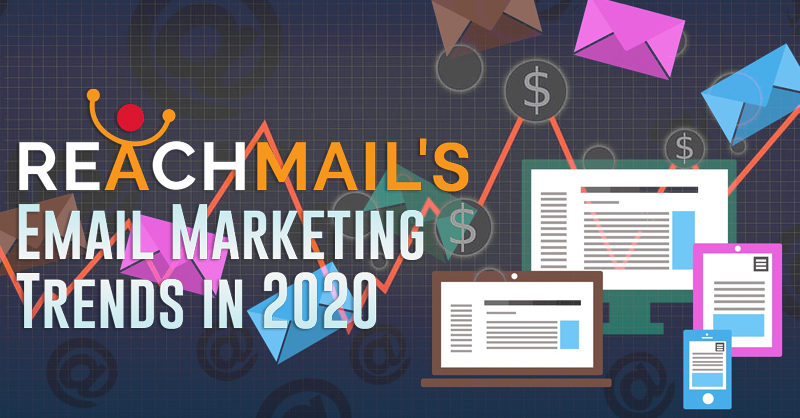
Expanding upon the concepts of Multi-Track Delivery Strategies discussed in the previous posts, we jump right back to Engagement, Targeting, and Dynamic Segmentation of traffic.
Prioritizing delivery to the recipients most likely to engage helps establish a strong footing for your marketing campaigns. This ties in closely with Multi-track email marketing efforts. You want to spend the bulk of your efforts interacting with customers that you know are interested.
When you send to a highly engaged audience, networks tracking the interactions (Gmail/Yahoo/Outlook) will profile the campaign as one that generates interest from the audience which leads to greater inbox placement of mail. By delaying or de-prioritizing deliveries to recipients that have not engaged recently with your offers, you increase the chances inboxing for all recipients in your distribution.
That’s not to say you should forget everyone else entirely even if the ROI is libel to be lower with less engaged individuals. A re-engagement drip-campaign using the AutoMessages is a great way make the automate the process so you can focus efforts elsewhere.
To be sure, you should limit the amount of mail you send to those that rarely or never engage with offers. Continuing to send mail to recipients that never or rarely engage will degrade inbox placement.
This may seem like a lot, but keep in mind that ReachMail collects engagement data for your recipients automatically on the back end. The recent interaction dates are stored in the list with each address. You can quickly target delivery to the most engaged by checking a box on the scheduling page using the Segments section.
Every account has 4 dynamic List Segments built in to target that were recently added, opened, or clicked recipients in the last 30, 60, 90, or 120 days.
You can build your own custom List Segments too. See here for more detail.
The quickest, easiest way to segment delivery only takes a single checkbox!
When you schedule mail 3 weeks out of 4 in a month, check the box to filter for recent engagement (say 30 day if you mail weekly). That last time, or the 4th week in the month, you don’t check the box and mail to everyone.
Now, 75% of the time, you’ve mailed to recently interested recipients that have a history of interaction with your offers. You’ve shifted your entire delivery profile with just a few clicks.
The best measure of success is an increase in total views. Not just an increase in the open rate, but an increase in total opened messages by sending to fewer people in a more targeted manner.

Last time we talked about boosting engagement from new sign ups. Today we’ll dig a bit deeper into multi-track and dynamic segmentation.
Let’s dive in.
Top marketers are running multi-track delivery strategies. Often incorporated with Dynamic Segments and Domain Segmentation, multi-track marketing seeks to target different sets of recipients within your audience to enhance performance. After-all, the key to inbox placement is sending relevant content to the recipients that want it.
The most commonly used segments focus on engagement:
Onboarding - This track is used to send engaging offers to newly opted in recipients to establish a series of interactions.
Re-engagement - For recipients that are less interested as of late. Similar to the onboarding process but should be treated as a distinct group of their own.
Most Engaged - Opened or clicked in the last 3-5 emails.
Somewhat Engaged - Opened or clicked in the last 5-15 emails.
Least Engaged - Opened or clicked in the last 16-30 emails.
Last week's post covers the onboarding track in more detail. Similar strategies can be incorporated to target other tracks. For example, with a new sign up, you would want to send a few messages in the first week, a re-engagement track would space 2-3 deliveries over the course of 2-3 months. No sense in continuing to waste time, money, and effort on recipients that generate 0 ROI at a risk to inbox placement for interested recipients.
Dynamic segments may sound like a fancy new buzzword but it’s something we’ve all seen before. The dynamic in Dynamic Segmentation refers to keeping track of recent engagement.
ReachMail’s standard List Segments already allow senders to use/build filters for open and click data. For example, a List Segment with the criteria: LastOpened more recent than 30 days ago is a Dynamic Segment since the open filter uses a dynamic time filter instead of a static date like. LastOpened more recent than January 1st, 2020.
AutoResponders have been completely revamped as AutoMessages for enhanced report, performance and exciting new capabilities coming soon.
AutoMessages will be out soon for everyone but you can enable them on your ReachMail account now from the User Settings under the Account Features section.
Let us know your use case. Everyone is bound to do things a little differently. Email us at support to tell how you would automate some of your email marketing tasks:
What’s a repeated task you would prefer to automate in ReachMail?
Is there a workflow or sequence of messages you want to segment automatically?
Do you want to help beta-test Automations?
We want to know what works for you so we can prioritize the most important enhancements for release first.

In 2020, engagement continues to remain the most talked about and researched topic of interest with regards to email delivery. Recency and relevancy are critical to successful email campaigns.
Almost a year ago Google announced it had been using TensorFlow, it's machine learning framework, to filter traffic in gmail and GSuite. The section titled "One person's spam is another person's treasure" hints at what we have seen in action for years now: delivery of email is personalized.
Google may be a pioneer in this area, but Yahoo, and MSN networks (hotmail, live, outlook) have also implemented machine learing spam filtering strategies of their own in recent years. As business migrate to Outlook365, Yahoo Business or GSuite domains, the distinction between B2B and B2C traffic is being blurred.
While the over-arching topic of engagement is unchanged from years past, the industry is looking to enhanced Automation, Dynamic Segmentation, and Multi-Track Email Marketing as ways to stay ahead. We'll get into more detail on those topics later on the series but for today we'll start with something any sender can setup: a warm-up track for new sign ups.
Consumer email networks place a huge emphasis on user engagement. If you're regularly sending to recipients that aren't opening and clicking on your emails at gmail/yahoo, it will affect inbox placement for other recipients within that network.
To boost performance from new sign up, send a series of engagement offers before sending revenue offers. The idea being to establish a pattern of interaction between you and the recipient before sending any revenue offers.
Take, for example, the case of a lifestyle blog.
New Sign Ups are first enrolled in a series of messages designed to boost engagement. Possible examples:
This creates a series of engagements or interactions with new followers right away and builds that pattern up early on, before you begin marketing to them. A drip-campaign with ReachMail's Auto-Messages is a great way to automate the sequence.
Recipients that are interacting with your emails on a regular basis are more likely to see future messages from you in their inbox.
|
 |
Retaining existing clientele is a matter of effective targeting. That means engaging offers that use interactions to boost engagement and segmenting your recipients when you send.
Enticing emails are concise and direct. Use high contrast items like images and buttons to naturally draw the eye’s attention to your primary CTA (Call To Action). ReachMail's Message Builder makes creating professional, mobile friendly content easy.
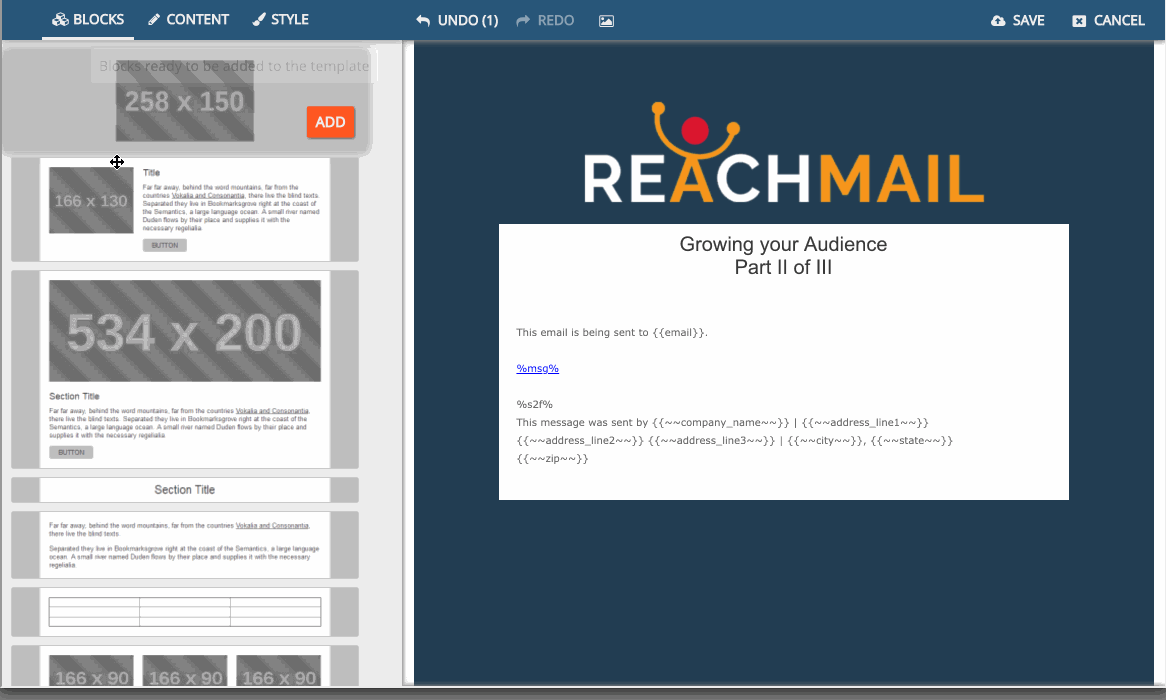
Everyone’s situation is a bit different. Here’s some segmentations to consider:
Effective segmentation means you can target different groups of recipients and tailor your messaging strategy to meet the needs of that group. Customers who have already purchased from you, for instance, are more likely to purchase again and thus don't need to be guided in that direct in the same way a new prospect might.
The key is treating recipients and individuals with their own set of preferences and needs. If you view your recipients as a means to an end, your message can come across as irrelevant and unnecessary. Maintaining a focused set of recipient groups can help you avoid this kind of confusion.
For example, say you're hosting an event in New York City and you don't target your offer to customers in that area. Someone in San Francisco might choose to unsubscribe from your list because you emailed them about an event on the other side of the country. Focused delivery will yield better delivery results and gain better traction with your audience.
Recipient engagement is key to ongoing success. No one wants to waste their time sending to disinterested recipients. It's imperative that you remove non-responders from all of your lists regularly.
That doesn't mean that you throw those addresses away for good, but instead, prioritize what you send to whom, and when.
Below we cover how to extract non-responders from a list so they can be targeted for an upcoming re-engagement campaign using ReachMail's Engagement Scanner.
With the filter's above using ReachMail's Engagement Scanner, we're doing the following:
Engaged (opened or clicked) with the last 90 days (#2 above)
37% of the list is engaged (Overview - #1 above)
Action: move non-responders to a new list called "Quarterly Re-Engagement List"
Stay tuned for our upcoming post on writing an effective re-engagement campaign.
We'll dig deeper into the following topics:
Increasing your target audience can be broken down into 3 distinct parts:
|
 |
When a new customer signs up, you want to reach out them right away. Any delay is a missed opportunity to connect and engage the new subscriber. AutoResponders in ReachMail allow you to schedule messages to be automatically sent to recipients based off their own sign up date.
Attach an immediate AutoResponder to be sent as a welcome message upon sign up. The welcome email is also your first chance to make the sale. Thank the new customer for their interest and send them some links to interesting items or a promotion you’re running.

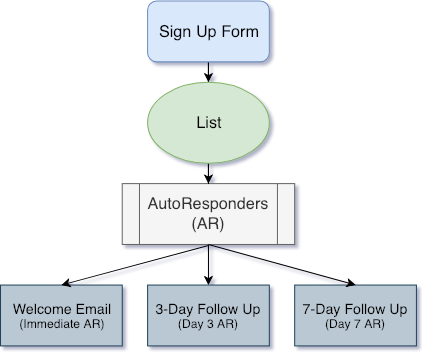 |
You can also attach several AutoResponder messages to the same list to achieve a fully automated Drip-Campaign. ReachMail's AutoResponders let you quickly create drip campaigns. Fully customizable, you can attach as many or as few AutoResponder messages as you need. The digram to the left (above if you're on a mobile device) shows a basic workflow of a 3 part Drip Campaign series. |
Once you set up the different Autoresponders, you’re done!
ReachMail will automatically send a sequence of messages to each recipient based off their sign up date. You can and should still send regular newsletters/offers in order to stay in touch but the Autoresponder delivery method will automate the on-boarding process for new subscribers.
Increasing your target audience can be broken down into 3 distinct parts:
|
 |
In this part, we'll cover building the form. Be sure to opt in to get the next parts emailed to you if you're not already on the list.
The current trends in sign up forms are moving towards a more minimalist design. Keep things simple by only asking for an email and maybe a first name.
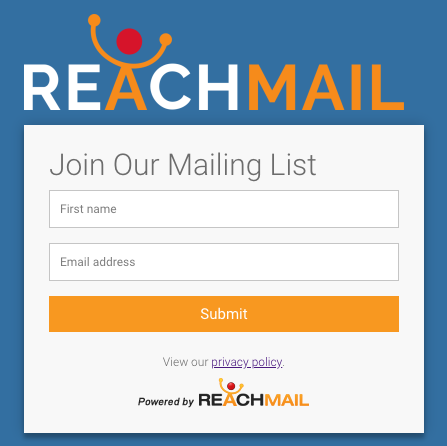
|
Too many fields can scare off customers Your sign up form is likely the first interaction you'll have with your new customer. Don't go overboard asking for tons of information. You might scare them off. If you need to collect more data, you can always do that in a second phase or maybe once the customer sets up their user in your application. |
When someone sign ups, thank them and tell them they've finished. ReachMail gives you an automatically generated confirmation page, but we encourage our customers to create their own.
Lower the barrier to entry as much as possible. Ask for the email, and maybe their name if you like. Anything else can be addressed later on once you've gained their trust.
Use a Double Opt In form when possible. This ensures that only valid email addresses make it in to you list and can help protect and bot signups flooding your forms with dangerous addresses. If you can't use double opt in it's important to use Signup Shield to ensure your list stays clean.
Ultimate Guide to Black Friday Email Marketing
Part 3 - Design Examples
Winning Examples
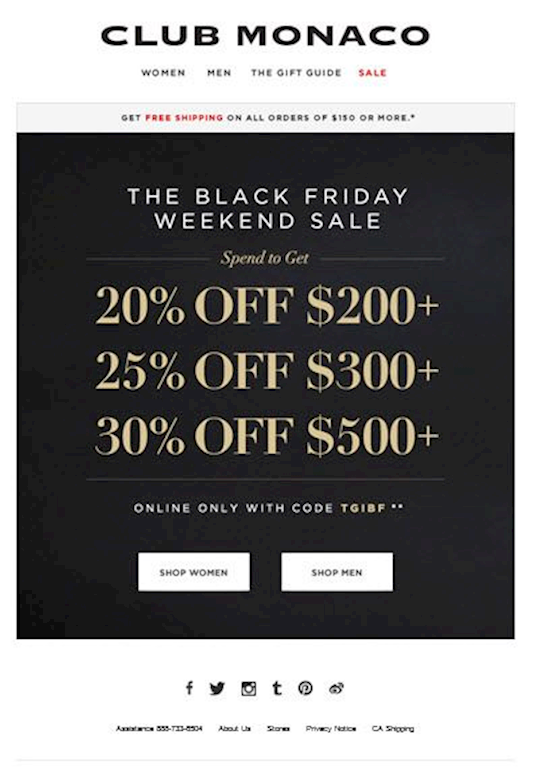
Why this works:
The content gets right down to business. There are clearly defined sales offers. Customer know exactly what to expect. Two CTA buttons are shown in high contrast for both target audiences.

Not So Winning Example:

What went wrong:
This message seems to prioritize a free shipping offer over the Black Friday sale. They earn points for clear CTAs in the message, but lose points for a cluttered email. There a total of 4 CTAs scattered throughout the message. Does each 'Shop Now' button lead to different deals?
The concept here seems to be: this message has something for everyone. In practice, this strategy tends to fall flat in email marketing though it may work well in print media.
Segmented (targeted) delivery of messages will increase revenue. We would recommend avoiding this format. You will see higher returns breaking up the content such that each message focuses on single CTA. Secondary/Follow Up CTAs can be employed to further entice anyone still on the fence (e.g. read more) but the content should remain focused.
Ultimate Guide to Black Friday Email Marketing
Part 2 - Dos and Don'ts
|
Do • use enticing Subject Lines • use fun aliterations in the subject • build a mobile friendly message • target your content • use bold CTAs • remove disengaged recipients |
Don't • use lots of exclamation marks!!!!! • USE ALL CAPS • assume your message is fine as is • send everything and hope for the best • send overly busy content • try to re-engage idle subscribers |
The Subject Line
The subject line is the first thing to get noticed before recipients open a message. Make sure it's succinct and clearly identifies the topic of your message.
In 2017, the use of the words: Sales, Black Friday, Free, and Holiday were some of the most common. % and off were also heavily used. We recommend something like:
"Black Friday - 20% off ReachMail account sign ups"
Don't be afraid to use alliteration and word play in your subject. An unexpected pun can catch the eye and lead to an open. That's half the battle.
The Message Content
Mobile friendly messaging is imperative. On average, nearly half of all opens occur on mobile devices. Ensuring your message is clear and actionable no matter what device is viewing the message is key. Use the Message Builder to guarantee proper display in all cases.
Using bold, high contrast CTAs (calls to action) in your message go a long way. Ask yourself: what do I want the recipient to do when they get this message? This is true for any campaign of course, but even more important during a busy mailing period like Black Friday. A new reader should be able to know exactly what they should do in a matter of seconds. Provide supporting information for anyone that needs it, but that should always be second to the CTA itself.
Remember, recipients are flooded with messages on Black Friday. It is not the time to send an overly busy message. Don't send one message with four topics. You'll bet better traction sending four one-topic messages. It's even better if you can target recipients by their preference for content.
Don't assume your message looks fine as is. Test it to be sure by using the Inbox Preview feature from Litmus.com to see what your message looks like on popular mobile and desktop displays. Free previews are included with any paid ReachMail account.
The List
Recipient engagement is one of the more overlooked concepts in email marketing and Black Friday promotions are no exception. Idle subscribers will act as a drain on your delivery. If someone hasn't opened or clicked on one your messages in the last six months, they probably aren't going to start now. Use the Engagement Scanner to filter out the non-responder and make sure you're list contains highly interested recipients.
Don't try to re-engage idle subscribers over the Black Friday season. Your idle subscribers may have become spam traps/honeypots or other threats. Quantity does not equaly quality in email marketing.
If for some reason you absolutely have to mail recipients that aren't responding, at the very least, set them aside into their own list with the Engagement Scanner so you can prioritize them differently. Mail to the engaged group first then mail to the disengaged recipients a few hours or a day later.
Ultimate Guide to Black Friday Email Marketing
Black Friday and Cyber Monday are some the highest volume email days of the year. Your recipients are most likely receiving tons of offers from other senders, and the ISPs are flagging loads of mail trying to prevent unwanted messages from cluttering inboxes. They key to success is differentiating your messages from all the other noise but how do you go about that, exactly? This newsletter will address strategies that you can deploy to ensure your messages stand out.
Part 1 - Key Concepts
Act Now
Don't wait. Starting your Black Friday messages early gives you chance to start warming recipients up to the idea. Don't over send either, but start a few weeks out by sending an alert to your core group of engaged recipients. The last week in October or the first week in November are good starting dates. Consider sending a message one month out, one week out, and then again during the Black Friday week/weekend itself.
Sending History
Your message does not exist in a vacuum. Your mailing history is like your credit score. It's the trust you build between you and your customers. If recipients are responding poorly to your mail, or not responding at all, it's time to re-evaluate your list. Expect that it's going to be harder than normal to gain traction on Black Friday. Targeting your core subscribers is a great way to make sure you stand out from the crowd.
Target
Everyone has a core set of recipients that interact with their messages more than others. Identify these people and treat them separately. These are the individuals that are most likely to make a purchase. Make sure you prioritize them over others in your lists. You should still make an outreach to all recent subscribers but by separating out the core group or most likely responders and messaging them first, you give yourself the best of chance of inboxing.
Focus
Keep it simple. Black Friday is NOT the time to send a message with multiple CTAs (calls to action). Make sure your message is simple and to the point. Use enticing images to promote your offers and high contract links/buttons that draw the readers eye to the action you wish them to take. A CTA button should be obvious and near the top of the email. Information overload in the email will lead to ignored messages. Show your message to a friend or colleague. If they can't tell exactly what you want them to do in 5-10 seconds, re-work your content.
Part 2 - Dos and Don'ts - common mistakes to avoid.
Part 3 - Design Examples - Industry leader examples and why they work